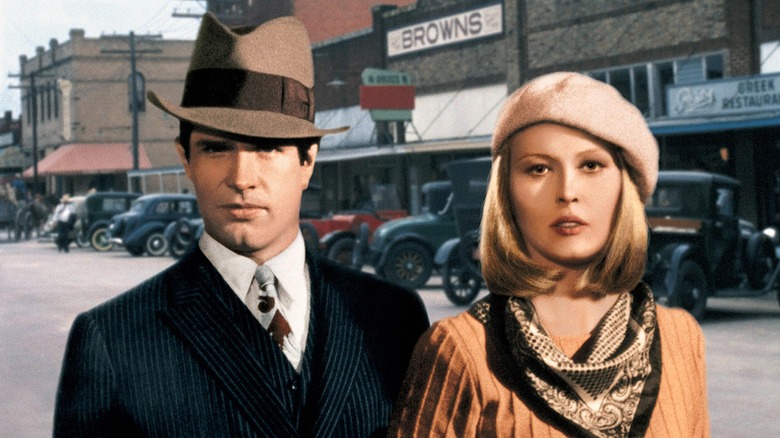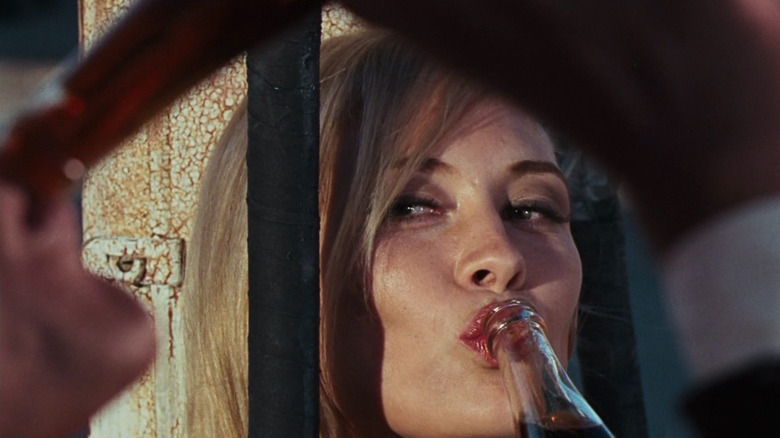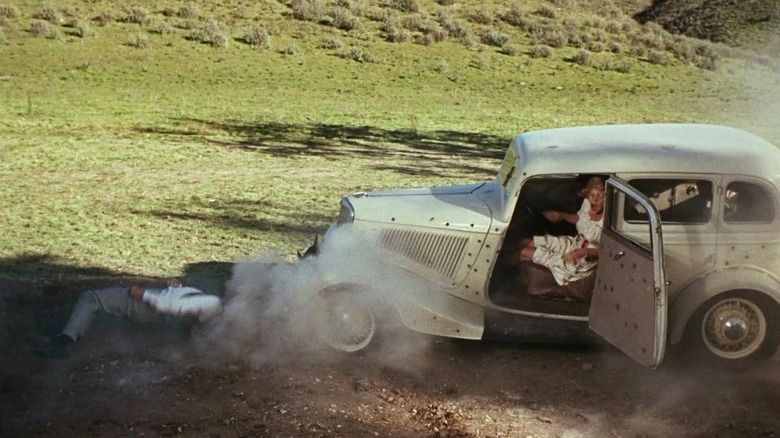The Bonnie And Clyde Controversy Explained
In 1967, the landscape of American cinema was changed forever with the release of "Bonnie and Clyde." It was one of the first films of the New Hollywood era, an inventive style of filmmaking that used unconventional storytelling techniques. Director Arthur Penn's spin on 1930s gangster movies had a counterculture sensibility that broke numerous cinematic taboos. It took critics and audiences some time to appreciate the film's radical spirit.
The story of the notorious twosome who went on a vicious crime spree during the Great Depression was retooled to reflect the turbulent late 1960s society. Bonnie and Clyde's anarchic rebellion resonated with a society in the midst of intense Vietnam War and civil rights protests. "Bonnie and Clyde" was a work of "grindhouse pulp" that "dunked the cinema in a baptism of style and blood and glamour and adulthood. It was a revolution both holy and unholy. From that moment on, American films would reach higher than they ever had — and lower," Owen Gleiberman writes in Variety.
Penn's sensational film immediately drew controversy and the ire of critics. Bosley Crowther wrote in his scathing New York Times review:
"It is a cheap piece of bald-faced slapstick comedy that treats the hideous depredations of that sleazy, moronic pair as though they were as full of fun and frolic as the jazz-age cut-ups in 'Thoroughly Modern Millie.'"
In Newsweek, Joe Morgenstern said "Bonnie and Clyde" was "a squalid shoot-em-up for the moron trade" (via The New Yorker). However, Morgenstern changed his initial opinion when he saw "Bonnie and Clyde" a second time and published a glowing review. Time magazine, who initially panned the movie, praised it in a cover story. This critical backpedaling helped draw viewers, and "Bonnie and Clyde" went on to become a sleeper hit at the box office and earn an Academy Award nomination for Best Picture.
"Bonnie and Clyde" shook the foundations of mainstream cinema, and there were two particular elements that attracted the most debate.
Strong sexual overtones
"Bonnie and Clyde" has a kinky energy that — when combined with its glamorization of sociopathic criminality — shocked audiences. Sex symbol Warren Beatty plays against type in his role of the impotent Clyde Barrow. Through his sexual incompetence, Penn makes the "provocative suggestion that his gun has, in a certain sense, replaced his penis," BBC observes. In one scene, the coquettish Bonnie Parker (Faye Dunaway) strokes the phallic symbol of Clyde's revolver, positioned directly in front of his groin and pointing towards her. This brief, lewd visual metaphor highlights the connection between Bonnie and Clyde's bloody crimes and sexual attraction. When the passionate pair first meet, she seductively puts the phallic neck of a Coke bottle close to her plump lips, a clear reference to oral sex.
There was even more sexual content in the original script. Clyde was written as bisexual, sharing a relationship with Bonnie and their male getaway driver. However, Penn felt that a third party would take away from the couple's electric bond and feared that homophobic viewers would write Bonnie and Clyde off as "sexually deviant." According to Senses of Cinema, Penn expressed his worries to screenwriters David Newman and Robert Benton:
"You're making a mistake, guys, because these characters are out there far enough. They kill people and rob banks. If you want the audience to identify with them, you're going to lose that immediately if you say this guy is homosexual. It's going to destroy the movie."
"Bonnie and Clyde" may have avoided the ambiguous history of Clyde's sexuality, but it still managed to ruffle feathers by featuring characters who not only responded to ruthless violence with glee, but were aroused by it. The graphicness of their savagery would become the most scandalous aspect of this screwball gangster movie.
A brutally violent ending
The dangerous couple meets their grim fate with realistic brutality that was mostly unprecedented on the big screen at the time. Bonnie and Clyde are massacred in a rainstorm of police bullets, their bodies spurting blood and flopping as if in some twisted ballet. The choppy cuts and uncomfortable close-ups add to the scene's chaotic feeling. The finale was, as Chris Nashawaty writes in Entertainment Weekly, "a prolonged and excruciating Grand Guignol spasm of gore. It was literally overkill." Nevertheless, the bloody sequence resonated with audiences in the wake of the JFK assassination and the horrors of the Vietnam war. Although it was set during the 1930s, "Bonnie and Clyde" could not be more timely, foreshadowing the violence that would ravage America in the coming years.
"Bonnie and Clyde" was one of the first films to extensively use squibs — small explosives filled with fake blood placed inside an actor's clothes — to simulate the graphic bullet hits. Before this film, death with so much blood and pain was rarely been seen on mainstream screens. Film critic Charles Champlin comments on the role "Bonnie and Clyde" plays in the history of cinematic violence (via Senses of Cinema):
"Under the old [Production] Code, you would see somebody be shot but you never saw the body being torn apart. You didn't make the link. Now, all at once, violent death could be communicated as a nearly physical sensation in full anatomical detail."
Penn's audacious shoot 'em up paved the way for films such as "The Wild Bunch" and "The Godfather" to use graphic, authentic bloodshed.
What disturbed audiences the most about "Bonnie and Clyde" was Penn's depiction of horrific crimes with a slapstick comedy tone; this zany style illustrates how killing satisfied Bonnie and Clyde's sadomasochistic desires. The couple truly enjoyed their lawless and homicidal existence. "Bonnie and Clyde" has a bold vision that interlaces violence and sex in a way that conventional audiences had never seen before. It is a deeply unsettling work that spoke to the shifting social climate during the late 1960s and would leave a lasting mark on Hollywood history.


